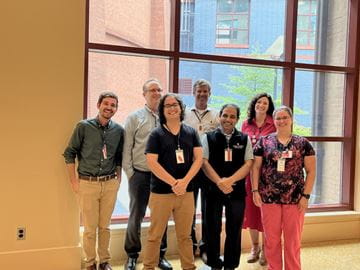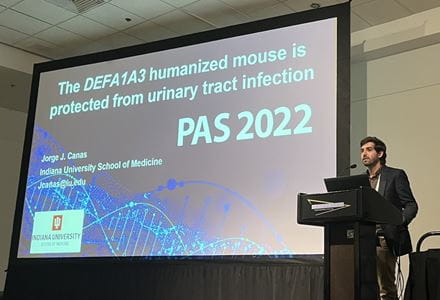Jorge Canas is completing his post-doctoral fellowship in the Hains Lab and was first author on a recent publication. Sydney Gendron, communications intern with pediatrics, spoke with him about his work and future.
Q: Can you explain your research in laymen’s terms?
A: My research focuses on the immune response to urinary tract infections. I study the first line of defense our body rapidly produces to combat microorganisms that can cause urinary tract infections, which is known as the innate immunity. Antimicrobial peptides are molecules that play functions throughout the innate immune response that can protect the host against the microbe invasion process.
Q: What is the significance of the work it highlights?
A: The research highlights the significant role of antimicrobial peptides (AMPs) in urinary tract infections. A major research focus has been devoted to understanding AMPs as biomarkers of disease, risk, severity, or prognosis.
Q: What are you leaning towards in your career?
A: I am currently training and working towards my doctorate degree in the Department of Microbiology and Immunology to achieve my goal of becoming an immunologist research investigator. My goal is to become an expert in the field area of host-derived antimicrobial peptides.
 Q: How did this research get started?
Q: How did this research get started?
A: The collaborative research between Dr. Hains and Schwaderer [David Hains, MD and Andrew Schwaderer, MD] started with a human retrospective study (JASN 2016). This novel research led to many medical and molecular questions in the fields of antimicrobial peptide and UTI host-genetics. To answer some of these throughout my graduate studies, I worked with the Kidney and Urology Translational Research team at Wells Center for Pediatric Research to build an animal model of human disease that recapitulates key aspects of UTIs using a genetic manipulated mouse containing the human gene. Our currently published research demonstrates the characterization of this genetic mouse model and its use to study the mechanisms between UTI protection and risk in association with the DEFA1A3 gene.
Q: What drew you to science?
A: Coming from Venezuela, my first laboratory experience was not until my junior year of a bachelor studies, working part-time in a Neurogenetics laboratory. I was fascinated by the combination of cell culture, animal models, and human clinical trial approaches developed by the research investigators to answer medical mysteries that would change the life of uncountable patients. After working for a few more years in other biomedical research laboratories in Florida and Boston, I became determined to build a future career to work on significant findings that can be translated from the laboratory bench to the clinic.
